Archbishop of York
The Archbishop of York is a senior bishop in the Church of England, second only to the archbishop of Canterbury. The archbishop is the diocesan bishop of the Diocese of York and the metropolitan bishop of the Province of York, which covers the northern regions of England (north of the Trent) as well as the Isle of Man. The archbishop of York is an ex officio member of the House of Lords and is styled Primate of England; the archbishop of Canterbury is the "Primate of All England".
Archbishop of York | |
|---|---|
| Archbishopric | |
| anglican | |
 Arms of the Archbishop of York: Gules, two keys in saltire the wards upwards argent in chief a regal crown proper[1] | |
| Incumbent: Stephen Cottrell since 9 July 2020 | |
| Style | The Most Revd and Rt Hon |
| Location | |
| Ecclesiastical province | York |
| Residence | Bishopthorpe Palace |
| Information | |
| First holder | Paulinus of York |
| Established | Bishopric in 626 Archbishopric in 735 |
| Diocese | York |
| Cathedral | York Minster |
| Website | |
| archbishopofyork | |
| Part of a series on |
| Anglicanism |
|---|
 |
|
|
The archbishop's throne (cathedra) is in York Minster in central York and the official residence is Bishopthorpe Palace in the village of Bishopthorpe outside York. The current archbishop is Stephen Cottrell, since the confirmation of his election on 9 July 2020.[2]
History
Roman
There was a bishop in Eboracum (Roman York) from very early times; during the Middle Ages, it was thought to have been one of the dioceses established by the legendary King Lucius. Bishops of York are known to have been present at the councils of Arles (Eborius) and Nicaea (unnamed). However, this early Christian community was later destroyed by the pagan Anglo-Saxons and there is no direct succession from these bishops to the post-Augustinian ones.
Saxon, Viking and Medieval times
The diocese was refounded by Paulinus (a member of Augustine's mission) in the 7th century. Notable among these early bishops is Wilfrid. These early bishops of York acted as diocesan rather than archdiocesan prelates until the time of Ecgbert of York,[lower-alpha 1] who received the pallium from Pope Gregory III in 735 and established metropolitan rights in the north. Until the Danish invasion the archbishops of Canterbury occasionally exercised authority, and it was not until the Norman Conquest that the archbishops of York asserted their complete independence.
At the time of the Norman invasion York had jurisdiction over Worcester, Lichfield, and Lincoln, as well as the dioceses in the Northern Isles and Scotland. But the first three sees just mentioned were taken from York in 1072. In 1154 the suffragan sees of the Isle of Man and Orkney were transferred to the Norwegian archbishop of Nidaros (today's Trondheim), and in 1188 all the Scottish dioceses except Whithorn were released from subjection to York, so that only the dioceses of Whithorn, Durham, and Carlisle remained to the archbishops as suffragan sees. Of these, Durham was practically independent, for the palatine bishops of that see were little short of sovereigns in their own jurisdiction. Sodor and Man were returned to York during the 14th century, to compensate for the loss of Whithorn to the Scottish Church.
Several of the archbishops of York held the ministerial office of Lord Chancellor of England and played some parts in affairs of state. As Peter Heylyn (1600–1662) wrote: "This see has yielded to the Church eight saints, to the Church of Rome three cardinals, to the realm of England twelve Lord Chancellors and two Lord Treasurers, and to the north of England two Lord Presidents." The bishopric's role was also complicated by continued conflict over primacy with the see of Canterbury.
English Reformation
At the time of the English Reformation, York possessed three suffragan sees, Durham, Carlisle and Sodor and Man, to which during the brief space of Queen Mary I's reign (1553–1558) may be added the Diocese of Chester, founded by Henry VIII, but subsequently recognised by the Pope.
Until the mid 1530s (and from 1553-1558) the bishops and archbishops were in communion with the pope in Rome. This is no longer the case, as the archbishop of York, together with the rest of the Church of England, is a member of the Anglican Communion.
Walter de Grey purchased York Place as his London residence, which after the fall of Cardinal Thomas Wolsey, was renamed the Palace of Whitehall.
Present
The archbishop of York is the metropolitan bishop of the Province of York and is the junior of the two archbishops of the Church of England after the archbishop of Canterbury.[4] The See is currently occupied by Stephen Cottrell since 9 July 2020.
The Province of York includes 10 Anglican dioceses in Northern England: Blackburn, Carlisle, Chester, Durham, Liverpool, Manchester, Newcastle, Sheffield, Leeds, and York, as well as 2 other dioceses: Southwell and Nottingham in the Midlands and Sodor and Man covering the Isle of Man.
List of archbishops
Pre-Conquest
| Bishops of York | |||
|---|---|---|---|
| From | Until | Incumbent | Notes |
| 625 | 633 | Paulinus | Formerly a monk at St. Andrew's Monastery in Rome; translated to Rochester; canonised.[5] |
| 633 | 664 | See vacant | |
| 664 | 669 | Chad | Resigned the see of York; later became Bishop of Mercia and Lindsey; canonised. |
| 664 | 678 | Wilfrid (I) | Ejected from York; later became Bishop of Selsey[lower-alpha 2]canonised. |
| 678 | 706 | Bosa | Canonised. |
| 706 | 714 | John of Beverley | Translated from Hexham; resigned the see; canonised in 1037. |
| 714 | 732 | Wilfrid (II) | Resigned the see; canonised. |
| c. 732 | 735 | Ecgbert | York elevated to Archbishopric in 735. |
| Pre-Conquest Archbishops of York | |||
| From | Until | Incumbent | Notes |
| 735 | 766 | Ecgbert | York elevated to Archbishopric in 735. |
| c. 767 | c. 780 | Æthelbert | Also known as Æthelbeorht, Adalberht, Ælberht, Aelberht, Aldbert or Æthelbert. |
| c. 780 | 796 | Eanbald (I) | |
| 796 | c. 808 | Eanbald (II) | |
| c. 808 | c. 834 | Wulfsige | |
| 837 | 854 | Wigmund | |
| 854 | c. 896 | Wulfhere | Fled the Danes in 872, returned in 873. |
| 900 | c. 916 | Æthelbald | Sometimes known as Æthelbeald, Athelbald, or Ethelbald. |
| c. 916 | 931 | Hrotheweard | Sometimes known as Lodeward. |
| 931 | 956 | Wulfstan (I) | |
| c. 958 | 971 | Oscytel | Also known as Oscytel. Translated from Dorchester. |
| 971 | Edwald | Also known as Edwaldus or Ethelwold. | |
| 971 | 992 | Oswald | Held both the sees of York and Worcester; canonised. |
| 995 | 1002 | Ealdwulf | Held both the sees of York and Worcester. |
| 1002 | 1023 | Wulfstan (II) | Also known as Lupus. Also held the see of Worcester (1002–1016). |
| 1023 | 1051 | Ælfric Puttoc | Also held the see of Worcester (1040–1041). |
| 1051 | 1060 | Cynesige | Also known as Kynsige. |
| 1061 | 1069 | Ealdred | Also known as Aldred. Held the see of Worcester 1046–1061, of Hereford 1056–1060, and of York 1061–1069. |
| Footnote(s):[lower-alpha 3] and Source(s):[8][9] | |||
Conquest to Reformation
| Archbishops of York (Conquest to Reformation) | |||
|---|---|---|---|
| From | Until | Incumbent | Notes |
| 1070 | 1100 | Thomas of Bayeux | Also known as Thomas (I). |
| 1100 | 1108 | Gerard | Translated from Hereford. |
| 1109 | 1114 | Thomas (II) | |
| 1119 | 1140 | Thurstan | He was elected in 1114, but was not consecrated until 1119. |
| 1140 | Waltheof of Melrose | Nominated Archbishop, but was quashed by King Stephen; later became Abbot of Melrose. | |
| 1140 |  Henry de Sully Henry de Sully |
Abbot of Fécamp Abbey. Nominated Archbishop, but was quashed by Pope Innocent II. | |
| 1143 | 1147 | William (FitzHerbert) | Deposed by Pope Eugene III; canonised in 1226. |
| 1147 | Hilary of Chichester | Deposed by Pope Eugene III, elected Bishop of Chichester. | |
| 1147 | 1153 | Henry Murdac | Formerly Abbot of Fountains Abbey. |
| 1153 | 1154 | William (FitzHerbert) (again) | Restored by Pope Anastasius IV; canonised in 1226. |
| 1154 | 1181 |  Roger de Pont L'Évêque Roger de Pont L'Évêque |
Formerly Archdeacon of Canterbury. |
| 1191 | 1212 | Geoffrey (Plantagenet) | Formerly Bishop-elect of Lincoln; elected archbishop in 1189, but was only consecrated in 1191. |
| 1215 | Simon Langton | Elected Archbishop of York in June 1215, but was quashed on 20 August 1215 by Pope Innocent III on request from King John; later became Archdeacon of Canterbury. | |
| 1216 | 1255 |  Walter de Gray Walter de Gray |
Translated from Worcester. |
| 1256 | 1258 | Sewal de Bovil | Formerly Dean of York. |
| 1258 | 1265 | Godfrey Ludham | Also known as Godfrey Kineton. Formerly Dean of York. |
| 1265 | William Langton | Dean of York (1262–1279); elected archbishop in March 1265, but was quashed in November 1265.[10] | |
| 1265 | 1266 | _-_Saint_Bonaventure.jpg.webp) Bonaventure Bonaventure |
Selected as archbishop in November 1265, but never consecrated and resigned the appointment in October 1266. |
| 1266 | 1279 | Walter Giffard | Translated from Bath and Wells. |
| 1279 | 1285 | William de Wickwane | |
| 1286 | 1296 | John le Romeyn | Also known as John Romanus. |
| 1298 | 1299 | Henry of Newark | Formerly Dean of York. |
| 1300 | 1304 | Thomas of Corbridge | |
| 1306 | 1315 | William Greenfield | Formerly Dean of Chichester |
| 1317 | 1340 | ||
| 1342 | 1352 | William Zouche | Also known as William de la Zouche. |
| 1353 | 1373 | Cardinal John of Thoresby | Translated from Worcester; created a Cardinal in 1361.[11] |
| 1374 | 1388 | Alexander Neville | Translated to St Andrew's in 1388. |
| 1388 | 1396 | 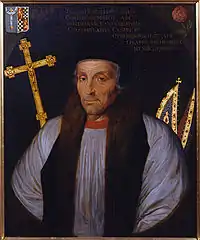 Thomas Arundel Thomas Arundel |
Translated from Ely; afterwards translated to Canterbury. |
| 1397 | 1398 | Robert Waldby | Translated from Chichester. |
| 1398 |  Walter Skirlaw Walter Skirlaw |
Bishop of Durham, elected but put aside by King Richard II. | |
| 1398 | 1405 | Richard le Scrope | Translated from Lichfield. |
| 1405 | 1406 | Thomas Langley | Elected Archbishop in August 1405, but was quashed in May 1406. |
| 1406 | 1407 |  Robert Hallam Robert Hallam |
Nominated Archbishop in May 1406 by Pope Innocent VII, but was vetoed by King Henry IV. |
| 1407 | 1423 | Henry Bowet | Translated from Bath and Wells. |
| 1423 | 1424 | Philip Morgan | Elected Archbishop in 1423, but was quashed in 1424. |
| 1424 | 1425 |  Richard Fleming Richard Fleming |
Conferred as Archbishop by Pope Martin V, but was refused by King Henry V, and Fleming resigned the appointment in July 1425. |
| 1426 | 1452 |  Cardinal John Kemp Cardinal John Kemp |
Translated from London; created a Cardinal in 1439;[12] translated to Canterbury. |
| 1452 | 1464 | William Booth | Translated from Lichfield. |
| 1465 | 1476 | George Neville | Translated from Exeter. |
| 1476 | 1480 | Lawrence Booth | Translated from Durham. |
| 1480 | 1500 |  Thomas Rotherham Thomas Rotherham |
Translated from Lincoln. |
| 1501 | 1507 | Thomas Savage | Translated from London. |
| 1508 | 1514 |  Cardinal Christopher Bainbridge Cardinal Christopher Bainbridge |
Translated from Durham; created a Cardinal in 1511.[13] |
| 1514 | 1530 |  Cardinal Thomas Wolsey Cardinal Thomas Wolsey |
Translated from Lincoln in 1514; created a Cardinal in 1515;[14] held with Bath and Wells 1518–23, Durham 1523–29 and Winchester 1529–30. |
| Source(s):[9][15][16][17] | |||
Post-Reformation
| Post-Reformation archbishops of York | |||
|---|---|---|---|
| From | Until | Incumbent | Notes |
| 1531 | 1544 |  Edward Lee Edward Lee |
Translated from St David's. |
| 1545 | 1554 | 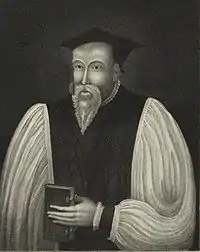 Robert Holgate Robert Holgate |
Translated from Llandaff. |
| 1555 | 1559 |  Nicholas Heath Nicholas Heath |
Translated from Worcester. |
| 1561 | 1568 |  Thomas Young Thomas Young |
Translated from St David's. |
| 1570 | 1576 |  Edmund Grindal Edmund Grindal |
Translated from London; afterwards translated to Canterbury. |
| 1577 | 1588 |  Edwin Sandys Edwin Sandys |
Translated from London. |
| 1589 | 1594 |  John Piers John Piers |
Translated from Salisbury. |
| 1595 | 1606 | .jpg.webp) Matthew Hutton Matthew Hutton |
Translated from Durham. |
| 1606 | 1628 | _Matthew_from_NPG.jpg.webp) Tobias Matthew Tobias Matthew |
Translated from Durham. |
| 1628 |  George Montaigne George Montaigne |
Translated from Durham. | |
| 1629 | 1631 |  Samuel Harsnett Samuel Harsnett |
Translated from Norwich. |
| 1632 | 1640 |  Richard Neile Richard Neile |
Translated from Winchester. |
| 1641 | 1646 |  John Williams John Williams |
Translated from Lincoln. Deprived when the English episcopacy was abolished by Parliament. Died 1650. |
| 1646 | 1660 | The see was abolished during the Commonwealth and the Protectorate.[18][19] | |
| 1660 | 1664 | 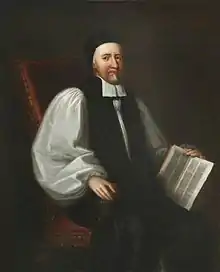 Accepted Frewen Accepted Frewen |
Translated from Lichfield. |
| 1664 | 1683 |  Richard Sterne Richard Sterne |
Translated from Carlisle. |
| 1683 | 1686 |  John Dolben John Dolben |
Translated from Rochester. |
| 1688 | 1691 | 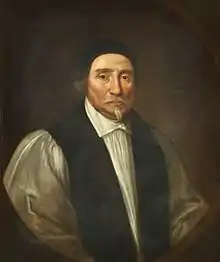 Thomas Lamplugh Thomas Lamplugh |
Translated from Exeter. |
| 1691 | 1714 | 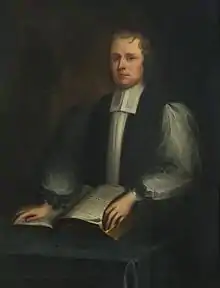 John Sharp John Sharp |
Formerly Dean of Canterbury. |
| 1714 | 1724 |  Sir William Dawes, Bt. Sir William Dawes, Bt. |
Translated from Chester. |
| 1724 | 1743 | %252C_Archbishop_of_York.jpeg.webp) Lancelot Blackburne Lancelot Blackburne |
Translated from Exeter. |
| 1743 | 1747 |  Thomas Herring Thomas Herring |
Translated from Bangor; afterwards translated to Canterbury. |
| 1747 | 1757 |  Matthew Hutton Matthew Hutton |
Translated from Bangor; afterwards translated to Canterbury. |
| 1757 | 1761 |  John Gilbert John Gilbert |
Translated from Salisbury. |
| 1761 | 1776 |  Robert Hay Drummond Robert Hay Drummond |
Translated from Salisbury. |
| 1776 | 1807 |  William Markham William Markham |
Translated from Chester. |
| 1808 | 1847 | .jpg.webp) Edward Venables-Vernon Edward Venables-Vernon |
Translated from Carlisle. Surname changed from Venables-Vernon to Venables-Vernon-Harcourt in 1831. |
| 1847 | 1860 |  Thomas Musgrave Thomas Musgrave |
Translated from Hereford. |
| 1860 | 1862 |  Charles Longley Charles Longley |
Translated from Durham; afterwards translated to Canterbury. |
| 1862 | 1890 |  William Thomson William Thomson |
Translated from Gloucester. |
| 1891 |  William Connor Magee William Connor Magee |
Translated from Peterborough. | |
| 1891 | 1908 retired |
 William Maclagan William Maclagan |
Translated from Lichfield. |
| 1909 | 1928 |  Cosmo Gordon Lang Cosmo Gordon Lang |
Translated from Stepney; afterwards translated to Canterbury. |
| 1929 | 1942 |  William Temple William Temple |
Translated from Manchester; afterwards translated to Canterbury. |
| 1942 | 1955 retired |
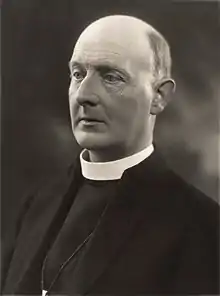 Cyril Garbett Cyril Garbett |
Translated from Winchester. |
| 1956 | 1961 |  Michael Ramsey Michael Ramsey |
Translated from Durham; afterwards translated to Canterbury. |
| 1961 | 1974 | .jpg.webp) Donald Coggan Donald Coggan |
Translated from Bradford; afterwards translated to Canterbury. |
| 1975 | 1983 retired |
 Stuart Blanch Stuart Blanch |
Translated from Liverpool. |
| 1983 | 1995 retired |
.jpg.webp) John Habgood John Habgood |
Translated from Durham. |
| 1995 | 2005 retired |
 David Hope David Hope |
Translated from London. |
| 2005 | 2020 retired |
 John Sentamu[20] John Sentamu[20] |
Translated from Birmingham; retired 7 June 2020.[21] |
| 2020 | present | .jpg.webp) Stephen Cottrell[22] Stephen Cottrell[22] |
Translated from Chelmsford; election confirmed 9 July 2020.[2] |
| Source(s):[9][23][24] | |||
Archbishops who became Peers
From 1660 to 1900, all the Archbishops of York died in office (or were translated to Canterbury and died in that office).
William Maclagan was the first to voluntarily resign his office in 1908, two years before his death. All of his successors who were not translated to Canterbury have also resigned their office before death, and (like all Archbishops of Canterbury) have been offered a peerage upon resignation,[lower-alpha 4] except for John Sentamu in 2020 whose peerage was delayed until the second 2020 Political Honours list:[25]
| Archbishop | Title | Notes | |
|---|---|---|---|
| Cosmo Gordon Lang | Baron Lang of Lambeth in 1942 | Extinct in 1945 | as Archbishop of Canterbury |
| Michael Ramsey | Baron Ramsey of Canterbury for life in 1974 | Extinct in 1988 | |
| Donald Coggan | Baron Coggan for life in 1980 | Extinct in 2000 | |
| Stuart Blanch | Baron Blanch for life in 1983 | Extinct in 1994 | |
| John Habgood | Baron Habgood for life in 1995 | Extinct in 2019 | |
| David Hope | Baron Hope of Thornes for life in 2005 | Extant | |
| John Sentamu | Title yet to be announced | Extant | |
Footnotes
- Paulinus was appointed Archbishop of York by Pope Honorius I in 634, but the appointment was not effective since it occurred after Paulinus had fled from York and become Bishop of Rochester.[3]
- Although Wilfrid established a monastic community in Selsey, there are no early sources that describe him as bishop of the South Saxons. Wilfrid is credited with being first bishop of the South Saxons, by William of Malmesbury and Florence of Worcester, also on some later Ecclesiastical lists, but he was still technically Bishop of York when in charge of Selsey Abbey. Therefore, as Sussex had been annexed by Wessex then Selsey probably would have been subject to the Diocese of the West Saxons, when Wilfrid was there.[6]
- The second edition of the Handbook of British Chronology listed Æthelric to have been archbishop of York from 1041 to 1042,[7] but in the third edition he is no longer listed to have been archbishop.[8]
- William Temple died in office (as Archbishop of Canterbury), and Cyril Garbett died before his hereditary peerage could be created.
Assistant bishops
Among those who have served as assistant bishops of the diocese have been:
- 1929 – 1931 (res.): Bernard Heywood — overseeing the Archdeaconry of the East Riding — former Bishop of Southwell; became Bishop suffragan of Hull (i.e., effectively the same role) and Archdeacon of the East Riding[26]
- 1964 – 1970 (ret.): Mervyn Armstrong, Adviser on Industry to the Archbishop of York and former Bishop of Jarrow[27]
- 1969 – 1996 (d.): George Cockin, Rector of Bainton (until 1978) and former Bishop of Owerri[28]
- 1977 – 1994 (d.): Richard Wimbush, Priest-in-charge of Etton with Dalton Holme (until 1983) and former Bishop of Argyll and The Isles and Primus[29]
See also
References
Citations
- Debrett's Peerage, 1968, p.1173, with added "the wards upwards" for clarity, as per Debrett's blazon for Bishop of Gloucester
- Costambeys "Paulinus (St Paulinus) (d. 644)" Oxford Dictionary of National Biography
- Fryde et al. 1986, Handbook of British Chronology, 3rd Edition, pp. 224, and 281–284.
- St. Paulinus, Archbishop of York. Retrieved on 20 November 2008.
- Foot 2011 The Bishops of Selsey and the Creation of a Diocese for Sussex. pp. 90-101.
- Powicke & Fryde 1961, Handbook of British Chronology, 2nd Edition, p. 257.
- Fryde et al. 1986, Handbook of British Chronology, 3rd Edition, p. 224.
- "Historical successions: York". Crockford's Clerical Directory. Retrieved 8 August 2013.
- William de Langeton alias of Rotherfield Archived 22 June 2011 at the Wayback Machine. Retrieved on 20 November 2008.
- John Cardinal Thoresby. The Cardinals of the Holy Roman Church. Retrieved on 20 November 2008.
- John Cardinal Kempe. The Cardinals of the Holy Roman Church. Retrieved on 20 November 2008.
- Christopher Cardinal Bainbridge. The Cardinals of the Holy Roman Church. Retrieved on 20 November 2008.
- Thomas Cardinal Wolsey. The Cardinals of the Holy Roman Church. Retrieved on 20 November 2008.
- Fryde et al. 1986, Handbook of British Chronology, 3rd Edition, pp. 281–283.
- Greenway 1999, Fasti Ecclesiae Anglicanae 1066–1300, volume 6, pp. 1–7.
- Jones 1963, Fasti Ecclesiae Anglicanae 1300–1541, volume 6, pp. 3–5.
- Episcopacy. British Civil Wars, Commonwealth and Protectorate 1638–60. Retrieved on 30 July 2013.
- King, Peter (July 1968). "The Episcopate during the Civil Wars, 1642–1649". The English Historical Review. Oxford University Press. 83 (328): 523–537. doi:10.1093/ehr/lxxxiii.cccxxviii.523. JSTOR 564164.
- The Archbishop of York Archived 3 December 2008 at the Wayback Machine. The official website of Dr John Sentamu, Archbishop of York. Retrieved on 21 November 2008.
- "Archbishop of York Dr John Sentamu to retire". BBC News. Retrieved 2 October 2018.
- "Bishop Stephen Cottrell to be the next Archbishop of York". The Church of England. Retrieved 17 December 2019.
- Fryde et al. 1986, Handbook of British Chronology, 3rd Edition, pp. 283–284.
- Horn & Smith 1979, Fasti Ecclesiae Anglicanae 1541–1857, volume 4, pp. 1–5.
- Sherwood, Harriet (18 October 2020). "John Sentamu peerage snub criticised as 'institutional prejudice'". The Guardian. Retrieved 30 October 2020.
- "Heywood, Bernard Oliver Francis". Who's Who. ukwhoswho.com. A & C Black, an imprint of Bloomsbury Publishing plc. (subscription or UK public library membership required)
- "Armstrong, Mervyn". Who's Who. ukwhoswho.com. A & C Black, an imprint of Bloomsbury Publishing plc. (subscription or UK public library membership required)
- "Cockin, George Eyles Irwin". Who's Who. ukwhoswho.com. A & C Black, an imprint of Bloomsbury Publishing plc. (subscription or UK public library membership required)
- "Wimbush, Richard Knyvet". Who's Who. ukwhoswho.com. A & C Black, an imprint of Bloomsbury Publishing plc. (subscription or UK public library membership required)
Sources
- Fryde, E. B.; Greenway, D. E.; Porter, S.; Roy, I., eds. (1986). Handbook of British Chronology (3rd, reprinted 2003 ed.). Cambridge, England: Cambridge University Press. ISBN 0-521-56350-X.
- Greenway, D. E. (1999). "Archbishops of York". Fasti Ecclesiae Anglicanae 1066–1300. Volume 6: York. British History Online.
- Jones, B (1963). "Archbishops of York". Fasti Ecclesiae Anglicanae 1300–1541. Volume 6: Northern Province (York, Carlise and Durham). British History Online.
- Foot, Sarah (2011). Foster, Paul; Moriarty, Rachel (eds.). The Bishops of Selsey and the creation of a Diocese in Sussex. Chichester - The Palace and its Bishops. Otter memorial Paper. 27. Chichester: University of Chichester. ISBN 978-1-907852-03-9.
- Horn, J. M.; Smith, D. M. (1979). "Archbishops of York". Fasti Ecclesiae Anglicanae 1541–1857. Volume 4: York Diocese. British History Online.
- Powicke, F. Maurice; Fryde, E. B., eds. (1961). Handbook of British Chronology (2nd ed.). London: Offices of the Royal Historical Society.
Further reading
- Story, Joanna (August 2012). "Bede, Willibrord and the Letters of Pope Honorius I on the Genesis of the Archbishopric of York". English Historical Review. cxxvii (527): 783–818. doi:10.1093/ehr/ces142.